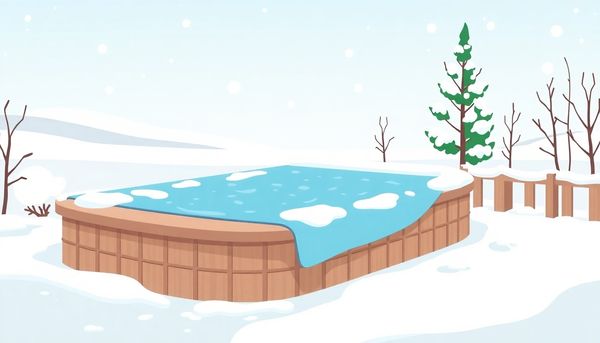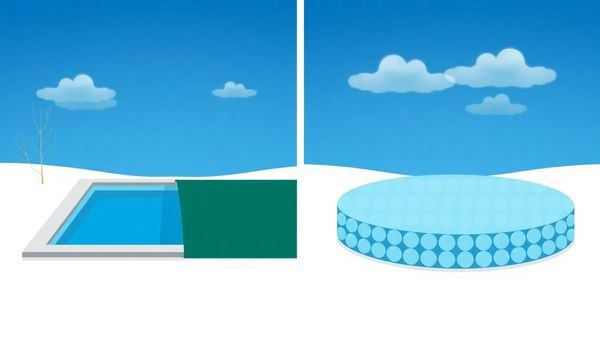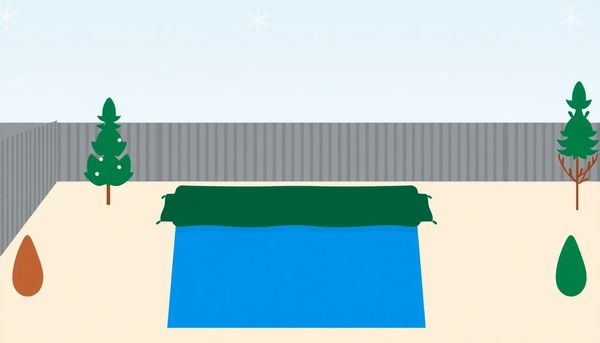Top Winter Pool Covers for 2025: Protect Your Pool All Season
August 06th, 2024
August 06th, 2024
Winter is approaching, and for pool owners, it’s a season of preparation. As the days grow shorter and the air turns crisp, thoughts inevitably shift to safeguarding that shimmering oasis in the backyard. Choosing the right winter pool cover is not just about keeping leaves and debris at bay; it’s about preserving the integrity of your pool for the warmer months ahead.
During my own search for a winter cover last year, I stumbled upon an array of options. From durable mesh covers that let water pass through while blocking debris, to solid vinyl covers that act as a protective shield against the harshest elements, the choices seemed endless. Each type offers distinct advantages, tailored to different climates and pool types, whether inground or above ground.
The process of selecting the ideal winter cover is akin to choosing the perfect winter coat—it must be functional, resilient, and well-suited to withstand the elements it will face. It’s about making an investment that ensures peace of mind throughout the frosty months, knowing that when spring arrives, your pool will be ready to welcome you back with open arms. This guide delves into the best winter pool covers available in 2024, equipping you with the knowledge to make a well-informed decision tailored to your specific needs and environment.

Choosing the right pool cover for winter isn't just about picking the first thing that fits. It’s a thoughtful process, akin to selecting the perfect winter coat—you need something durable, protective, and suited to your environment. When it comes to pool covers, you’ve got options, each with its own set of advantages tailored to different needs and styles.
Think about the climate you live in. If winters are harsh, with snowfall and gusty winds, a sturdy solid cover might be your best bet. These covers are excellent at sealing out debris and preventing algae growth by blocking sunlight. But remember, they do collect water, so be prepared to invest in a cover pump to manage the weight of accumulated rain and snow.
On the flip side, mesh covers offer a different set of perks. Allowing water to drain into the pool, they reduce maintenance by letting you skip the chore of pumping off excess water. They act as a sieve, keeping out leaves and twigs while offering peace of mind with built-in safety features, especially if you have children or pets.
Now, consider your pool type. Inground pools benefit from safety covers that anchor securely to prevent accidents, while above ground pools often rely on simpler tarp-style covers tightened with a winch system. Whichever you choose, ensure it’s the right fit, both in size and in meeting your winter needs. This decision is more than just an investment in your pool—it’s a safeguard for your backyard oasis during the winter months.
When the snowflakes begin their gentle descent, cloaking everything in sight, the time arrives to consider shielding your pool with the ideal winter cover. Choices abound, from robust mesh covers to economical tarps, each offering a unique blend of protection, convenience, and budget-friendliness. Mesh covers, for instance, are a favorite among pool owners who value hassle-free maintenance. They allow rain and snow to seep through, leaving dry debris that can be easily swept away when spring arrives. This makes them a stellar option for those looking to reduce labor-intensive clean-ups once warm weather returns.
Solid covers, while requiring a bit more upkeep like water pumping to prevent sagging, excel at keeping sunlight and debris out, ensuring your pool water stays cleaner and algae-free. Crafted to withstand the rigors of winter, these covers promise not only protection but peace of mind. For the budget-conscious, basic tarp-style covers provide a no-frills solution that, when secured properly, can guard against winter’s chill. Though they may lack the durability of more permanent covers, they serve as a practical choice for those who don’t mind an annual purchase.
Ultimately, selecting a winter cover for your pool is much like dressing for the season—it’s all about finding that perfect balance between functionality and personal preference. With the right cover, you’ll ensure that your pool isn’t just surviving the winter, but poised to shine brightly come pool season.
Understanding the benefits of different pool cover materials can be the game-changer in maintaining your pool throughout the chilly months. Each material offers unique advantages, tailored to various conditions and preferences. Let's take a closer look.
A walk through the options starts with solid covers. These are the stalwarts of pool covers, crafted to keep every trace of debris and light at bay. This minimizes the risk of algae blooms, which thrive on sunlight. However, they do require a bit of extra care, as water accumulation on top can create a sag. A reliable pump makes this task manageable, ensuring your pool remains pristine underneath.
Then there's the mesh variety, celebrated for its convenience. While it sacrifices some debris-blocking capabilities, it allows rainwater and snow melt to filter through, reducing the need for frequent pumping. This can be particularly appealing if you're seeking a balance between maintenance and effectiveness. Mesh also dries quickly in the sun, making it easier to clean.
Lastly, polyethylene or polypropylene-made covers are the ultimate defenders against harsh winter elements. These materials are akin to your favorite winter coat—durable, resistant to UV damage, and built to last. They form a protective barrier that handles the weight of snow and withstands wind. Investing in such a cover is like securing a steadfast guardian for your pool, offering peace of mind and less hassle come spring.
In the end, selecting the right cover material is about aligning it with your climate challenges and maintenance preferences. Whether prioritizing cleanliness, ease, or durability, understanding these material benefits is the first step toward a worry-free winter pool season.
An essential step in preparing your pool for winter is ensuring the cover is correctly installed. It might seem straightforward, but even small mishaps can lead to significant problems. For instance, a slightly loose cover might allow debris to sneak in, or worse, cause the cover to sag and collect water, potentially tearing under the weight of snow or ice.
First, consider the specific type of cover you have chosen. Solid and mesh covers for inground pools typically require anchors drilled into the pool deck. This ensures the cover remains taut and secure. It's akin to making sure a tent is properly staked down before a windy night; you wouldn't want it flapping around, right? For above ground pools, the cover generally drapes over the water surface and is tightened using a winch and cable system through grommets around the pool's perimeter.
One weekend, I helped a friend install his new pool cover. We discovered that positioning the cover evenly before securing it is crucial. If one side is tighter than the other, it can lead to uneven tension, increasing wear and tear. We also learned that adding a few water bags along the edges of the cover helps keep it in place during gusty weather. Think of these as weights that prevent your cover from acting like a parachute.
Finally, after installation, regularly check your cover throughout the winter. Remove any accumulated snow or water promptly to avoid strain. A simple cover pump can be a handy investment, ensuring your pool cover remains in pristine condition until spring.

Guarding your pool during the cold months isn't just about peace of mind; it's about preserving your backyard oasis for the return of warmer weather. Deciding on the right winter pool cover can transform a tedious task into a straightforward solution. Just last winter, a friend of mine learned this the hard way. They went with a basic tarp cover, only to find it ripped and sagging under snow weight, leading to a murky cleanup come spring.
To truly safeguard your pool, it's essential to select a cover that can handle winter’s harsh grip. For inground pools, a well-fitted mesh safety cover, such as those from trusted names like Loop-Loc, offers unparalleled durability and ease of maintenance. These covers are designed to allow water to drain while trapping debris, preventing it from entering your clean pool water. This minimizes post-winter cleanup, an advantage my friend wished they had considered earlier.
Above ground pool owners aren’t left out in the cold, either. Opt for covers with a high scrim count and robust cable systems, ensuring a snug fit. Coupled with water tubes or bags, these covers remain secure, even during stormy weather. An added bonus? These covers often include warranties that speak to their longevity, a wise investment for those who dread annual replacements. With the right winter pool cover, you not only shield your pool from damage but also set the stage for a seamless transition back to swimming season.
Choosing the right winter cover for your pool is akin to finding the perfect winter coat for yourself—it must fit well, endure tough conditions, and serve its primary purpose with minimal fuss. When selecting a winter pool cover, consider the climate you live in and the type of pool you own. For harsh, snowy winters, a robust, high-density polyethylene cover with UV inhibitors provides resilience against the elements and sun damage. This type of cover efficiently blocks out debris, reducing the effort required to prepare your pool for spring.
Options abound, from solid covers to mesh variants, each with its benefits. Solid covers offer maximal protection against debris and algae formation by blocking sunlight entirely. However, they can collect water on top, necessitating a pump to remove the excess liquid—much like keeping your driveway shoveled post-snowstorm. In contrast, mesh covers allow water to pass through while capturing leaves and twigs, making them a more convenient, low-maintenance option for busy pool owners.
If safety is a priority, especially with children or pets around, a dense mesh safety cover by Loop-Loc is highly recommended. Though an investment, it ensures peace of mind and is known for its durability. Always measure your pool accurately before purchasing, as most covers are designed to overlap pool edges by about four to five feet. Finally, remember that while colors might be purely aesthetic, choosing a cover designed to match your specific needs is crucial for a worry-free winter.
Securing your pool safely during the chilly months is more than just a practical task—it's an investment in peace of mind. Winter, with its unpredictable temperament, can transform a serene pool into a hazard if not properly covered. From personal experience, a well-secured cover not only protects your pool but also ensures the safety of curious kids and wandering wildlife.
For inground pools, a robust safety cover is your best bet. These covers, often made of durable mesh or solid fabric, are anchored securely around the pool's perimeter. They strike the perfect balance between safety and maintenance ease, allowing rainwater and melted snow to filter through while keeping debris out. During a particularly stormy winter a few years back, my own mesh cover saved us from the hassle of scooping out endless leaves and twigs come spring.
Above ground pools, too, benefit from a thoughtful approach to covering. A solid winter cover, paired with a tight winch and cable system, ensures a snug fit. Adding water bags or tubes along the edges can prevent wind from sneaking underneath. This strategy helped a neighbor of mine last winter; while others struggled with flapping covers, his remained steadfast.
In essence, securing your pool properly is about diligence and choosing the right tools. Whether inground or above ground, a well-secured cover transforms winter's challenges into mere trifles, safeguarding your pool and keeping worries at bay.
Choosing the right cover material for your pool is akin to picking the perfect coat for a winter storm; it must balance durability, functionality, and value. The market offers an array of options, each with its distinct advantages. Solid covers, for instance, are fantastic at blocking out sunlight and debris, effectively preventing algae growth. Yet they require a pump to manage the pooling water, which can be cumbersome. This choice suits those who prioritize a pristine pool come spring.
Conversely, mesh covers relieve you from the hassle of water accumulation by allowing rain and melting snow to pass through, while still barring leaves and larger debris. These covers are perfect for those who desire minimal maintenance during winter months, though they might allow a bit more light into the pool, possibly encouraging algae.
For more custom needs, reinforced polyethylene or polypropylene covers stand out. These materials boast exceptional tear resistance and UV protection, ensuring longevity against harsh weather conditions. They are the winter warriors of pool covers, designed to brave the elements while offering peace of mind.
Friends might share tales of budget-friendly tarps, but beware: these often require annual replacement and lack in durability, much like dressing for a blizzard in a windbreaker. It's crucial to weigh the long-term benefits of investing in a quality cover against the recurring costs of cheaper alternatives. Choose wisely, and your pool will remain shielded through the toughest of winters.

Winter's chill can do more than paint a picture of serenity over your backyard oasis; it can wreak havoc on your beloved pool if not properly shielded. A robust winter pool cover acts as a sentinel, warding off the seasonal threats of debris, snow, and ice, which, if left unchecked, can lead to costly repairs come spring.
Consider the experience of my neighbor, who once skipped the winter cover. What seemed like a cost-saving decision turned into a spring nightmare, with a swampy mess needing hours of cleanup and hefty repair bills. A quality cover not only keeps out leaves and critters but more importantly, it stabilizes the pool's chemistry by blocking sunlight, which otherwise fuels algae growth. This translates to fewer chemicals needed when reopening, saving time and money.
Different types of covers cater to various needs, whether you’re dealing with inground or above-ground structures. Solid covers offer a fortress-like barrier against light and debris but require a pump to manage water buildup on top. Meanwhile, mesh covers allow water to filter through, simplifying maintenance and reducing the risk of sagging under heavy snow. Ensuring your pool is swaddled in the right cover is akin to providing it with winter armor, preserving its condition and your peace of mind through the coldest months.
Selecting the ideal winter pool cover is akin to choosing the right jacket for a harsh winter. Each type serves a distinct purpose, tailored to different pool structures and climates. For inground pools, a robust safety cover, often made of durable mesh or solid material, is a prized choice. These covers not only guard against debris but also provide a crucial safety layer by preventing accidental falls into the pool. While they require a more involved installation process—drilling into the deck to secure the cover—the peace of mind they offer during the frosty months is unmatched.
Above ground pools, conversely, typically don a less complex but equally essential cover. These covers are often secured with a cable and winch system, integrating water bags or tubes to keep them in place against the elements. They are designed to keep out leaves and dirt, though they offer minimal safety features compared to their inground counterparts. Yet, they deliver a cost-effective solution for protecting your pool throughout the winter.
Both types of covers require care in selection. Consider the scrim count—a higher count indicates stronger fabric—and the warranty offered, which often reflects the cover's durability. Whether your priority is safety, ease of use, or budget, knowing the nuances of each cover option will lead you to make a choice that best suits your pool’s needs and your peace of mind during the chilling months of winter.
Securing and installing a pool cover for the winter months is akin to wrapping your prized possession in a snug, protective layer. The process begins with selecting the right type of cover, be it a solid, mesh, or hybrid design. Each has its merits: solid covers are impermeable, keeping out debris and blocking sunlight to prevent algae growth, while mesh covers allow water to pass through, reducing the dreaded puddle problem on top. Meanwhile, a hybrid combines these benefits, offering total coverage with minimal maintenance.
Upon choosing your cover, installation is the next step. For inground pools, the cover must be anchored securely around the pool deck. This typically involves drilling to insert anchors or using water bags to weigh down the edges if drilling isn’t an option. Above ground pools often use a cable and winch system to ensure a tight fit around the pool perimeter. Always ensure your cover lies flat, free of wrinkles that might collect debris or water.
Speaking from personal experience, investing in a quality cover and taking the time to install it correctly pays dividends. A few years back, a misstep in securing my pool cover left me with a leaf-filled mess come spring—lesson learned! Proper installation not only guards against debris but also ensures safety and longevity, saving both time and hassle when warmer weather beckons.
Maintaining the integrity of your winter pool cover is more art than science, a balance between preparation and care. The first step in this winter ritual is ensuring your chosen cover fits snugly over your pool, whether inground or above ground. A cover that's too loose or too tight invites trouble, from flapping in the wind to tearing under stress. So, measure twice, install once; it’s a mantra I learned after seeing my neighbor’s pool cover turn into a parachute during a windstorm.
Once the cover is in place, regular checks are crucial. This involves inspecting for any small tears or weaknesses. A stitch in time saves nine, as they say, especially when patches are far cheaper and easier than replacing an entire cover. Having dealt with a mid-winter mishap myself, I can attest to the peace of mind that comes from these inspections. Additionally, using a cover pump to remove excess water can prevent sagging and undue stress, allowing the cover to perform its protective duties without strain.
Finally, keeping your pool cover clean is more than just an aesthetic choice. Leaves and debris can create unnecessary weight and cause premature wear. I once made the mistake of letting autumn leaves sit too long, resulting in a soggy mess that was as enjoyable to clean as a mud pie. A simple broom or leaf blower can be your best allies here, keeping your cover in top shape through the toughest months.

When the first snowflakes begin their descent, ensuring your pool is well-protected becomes a priority. Over the years, friends have shared stories of battling leaves and twigs, only to open their pools in spring to a murky mess. A high-quality winter pool cover does more than just shield your pool; it cuts down your workload when warmer days return.
Start by considering the material. A robust mesh cover acts like a sentinel, allowing rain and snowmelt to filter through while keeping out larger debris like branches and leaves. This means less time spent fishing out soggy foliage come spring. On the other hand, solid covers block everything out, though you might face the challenge of pumping accumulated water off the surface to prevent sagging.
Installation is straightforward with the right tools. For inground pools, a cover secured with grommets and a winch system or water bags ensures a snug fit. Above ground, cable systems offer similar protection. Think back to that neighbor who struggled with a tarp flapping in the wind; investing in a proper winter cover saves you from such hassles.
In my experience, opting for a durable winter cover not only safeguards your pool through harsh conditions but also brings peace of mind. By choosing wisely, you transform winter’s icy grip into just another season, rather than a time of potential pool disaster.
#

Selecting the perfect winter pool cover is akin to finding the right coat for a chilly day—each has its own function and flair. For inground pool owners, two main types are prominent: solid and mesh safety covers. A solid cover is the heavy-duty option, blocking all sunlight and debris. While it keeps your pool pristine, it demands regular attention to pump off collected rain and snow. Think of it as a robust shield that requires a bit of maintenance but rewards you with a clean pool come spring.
Mesh covers, on the other hand, may be likened to a breathable jacket. They let water pass through while catching leaves and twigs. This means less winter upkeep but potentially more spring cleaning. If convenience tempts you, mesh could be the better choice. However, both types offer essential safety features, preventing accidental falls, especially if you have children or pets.
Above ground pools often use traditional tarp-style covers. They're budget-friendly and easy to set up with a cable and winch system. However, they offer no safety features and demand regular tightening and adjustments. Investing in water bags or tubes can enhance their stability against winter winds.
Ultimately, choosing the right cover depends on your climate, budget, and how much effort you're willing to exert over the winter months. Each type has its trade-offs, but with the right choice, you can ensure your pool weathers the winter well, ready to welcome summer with open arms.
Secure inground pool covers are an understated hero in the world of pool maintenance, particularly when winter rolls around. Think of them as the silent guardians that not only keep the elements at bay but also ensure safety. Unlike standard tarps that merely drape over the pool, these covers are anchored securely with a series of pins or ties into the concrete deck surrounding an inground pool. This setup offers a taut, elegant appearance while providing a crucial safety net against accidental falls.
When I first invested in a quality cover for my pool, I immediately noticed how it significantly reduced the spring cleanup hassle. Gone were the days of fishing out soggy leaves and debris, not to mention the improved peace of mind knowing the pool was safely sealed. These covers come in two main varieties: solid and mesh. Solid covers completely block sunlight and debris, but require diligent water removal from the surface. On the other hand, mesh covers allow rain and snowmelt to seep through, keeping the pool relatively clean underneath and eliminating the need for a cover pump.
Choosing a cover involves more than just picking a color that matches your patio decor. Quality is critical. High-density polyethylene or polypropylene materials are favored for their strength and UV resistance, ensuring longevity. Mesh covers, in particular, are praised for their convenience, reducing the backbreaking task of pumping water off the cover throughout the winter months. For anyone considering a cover, weighing the balance between convenience and maintenance is key to a hassle-free offseason.
When considering the lifespan of your winter pool cover, it's akin to nurturing a prized plant; attention and care reap the best results. Start with proper installation, ensuring the cover fits snugly over your pool, whether inground or above ground. This creates a secure barrier against winter’s relentless elements. Instead of battling sagging surfaces, invest in an air pillow for above ground pools. This simple addition prevents water accumulation, which can otherwise weigh down and damage the cover.
Regular maintenance throughout the cold months is equally crucial. Periodically inspect your cover for any signs of wear or holes that might allow debris to seep in. Repair minor damages promptly to prevent them from worsening. Utilizing a pool cover pump is ideal to remove any excess water, snow, or ice buildup, thereby preventing strain on the fabric.
When spring makes its return, cleaning and storing your cover correctly is your next mission. Rinse off any lingering debris and allow it to dry thoroughly before storage to prevent mildew. A dry, shaded location away from direct sunlight is best to avoid UV damage during the off-season.
These small, consistent efforts not only protect your pool but also extend the life of your winter cover, ensuring it remains a reliable guardian year after year. Like any investment, a bit of care goes a long way in preserving its value and functionality.

Selecting the right winter pool cover is akin to choosing a reliable shelter for your pool against the harsh elements of winter. Investing in a quality cover not only safeguards your pool from debris but also significantly reduces the workload when the time comes to open your pool again. A close friend once shared their experience of cutting corners with a cheaper cover, only to find themselves wrestling with algae and debris when spring arrived. Opting for a well-crafted cover might require a higher upfront cost, but it can save you hours of maintenance and frustration down the line.
Mesh covers are often a preferred choice due to their ability to let water pass through while keeping out unwanted debris, thereby reducing maintenance and eliminating the need for constant water pumping. For those who have children or pets, a safety cover such as those by Loop-Loc offers peace of mind with its robust design, preventing accidental falls into the pool. Alternatively, solid covers offer maximum protection from sunlight and debris, though they require diligent water removal from the top.
When shopping for a cover, pay close attention to details such as scrim count and warranty length; these are indicators of durability and longevity. Remember, a well-fitted cover should be snug yet allow for some give to handle accumulated snow and ice without tearing. Investing wisely in a quality winter pool cover is akin to purchasing a reliable winter coat—it may cost a bit more, but the comfort and protection it provides make it well worth the investment.
#

Understanding the different types of winter pool covers can be as puzzling as choosing the perfect coat for a brisk winter day. Each type offers distinct benefits, and selecting the right one depends on your pool type, budget, and the climate in which you live. Let's unravel this conundrum together.
For inground pools, the safety cover is often the hero of the winter season. Constructed from durable mesh or solid material, this cover is anchored securely around the pool and prevents both debris and unwelcome accidents. Solid covers, though excellent for keeping out debris and blocking sunlight (thus preventing algae growth), require diligent maintenance to avoid water accumulation, which can lead to sagging and potential safety hazards. Meanwhile, mesh covers allow rain and snowmelt to pass through, providing a simpler, low-maintenance option without sacrificing cleanliness.
As for above ground pools, affordability often steers owners towards tarps or simple winter covers. These sit atop the water and secure to the pool walls with cables and winches. While they efficiently keep out leaves and debris, they offer little in terms of safety. For those with a deck, a safety cover might be feasible, providing enhanced peace of mind during the offseason.
Each cover type has its strengths and trade-offs. Choosing wisely means considering how much maintenance you're willing to undertake and what level of protection your pool requires through the cold months. It’s about finding that balance between your pool’s needs and your own, ensuring a stress-free season.

This article provided insights into maintaining your pool. Start your pool care journey today!
Want to become a pool maintenance expert? Our free Pool School course covers everything you need to know about pool care. From basic maintenance to advanced troubleshooting, you'll learn how to:
Join over 10,000 pool owners who have already transformed their pool care routine. Get started with our free Pool School course today!